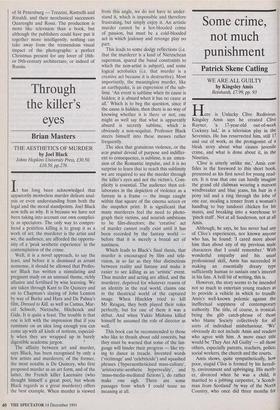Through the killer's eyes
Brian Masters
THE AESTHETICS OF MURDER by Joel Black Johns Hopkins University Press, £30.50, £10.50, pp.276 It has long been acknowledged that apparently motiveless murder defeats anal- ysis or even understanding from both the legal and the moral standpoints. Joel Black now tells us why. It is because we have not been taking into account our own complici- ty as spectators. The only way to compre- hend a pointless killing is to grasp it as a work of art; the murderer is the artist and we, the audience, are afforded the opportu- nity of a 'peak aesthetic experience' in the contemplation of the crime.
Well, it is a novel approach, to say the least, and before it is dismissed as arrant nonsense, it should be allowed that Profes- sor Black has written a stimulating and pregnant study on an unusual theme, richly allusive and fertilised by wise learning. We are taken through Kant to De Quincey and on to Chapman's slaying of John Lennon by way of Burke and Hare and De Palma's film, Dressed to Kill, as well as Camus, Mar- cel Schwob, Nietzsche, Hitchcock and Gide. It is quite a feast. The trouble is that one is left with the impression that if you ruminate on an idea long enough you can come up with all kinds of notions, especial- ly when they are wrapped up in barely digestible academic jargon.
The affinity between art and murder, says Black, has been recognised by only a few artists and murderers; of the former, the most notable is De Quincey, who first proposed murder as an art form, and of the latter, the French killer Lacenaire (who thought himself a great poet, but whom Black regards as a great murderer) offers the best example. When murder is viewed from this angle, we do not have to under- stand it, which is impossible and therefore frustrating, but simply enjoy it. An artistic murder cannot be a hot-blooded crime of passion, but must be a cold-blooded act in which jealousy and revenge play no part.
This leads to some dodgy reflections (i.e. that the murderer is a kind of Nietzschean superman, spared the banal constraints to which the non-artist is subject), and some logical acrobatics (i.e. that murder is a creative act because it is destructive). Most importantly, the meaningless murder, like an earthquake, is an expression of the sub- lime. 'An event is sublime when its cause is hidden; it is absurd when it has no cause at all.' Which is to beg the question, since if the cause is hidden, then there is no way of knowing whether it is there or not; one might as well say that. what is apparently absurd is secretly sublime, which is obviously a non-sequitur. Professor Black steers himself into these messes rather frequently.
The idea that gratuitous violence, or the acte gratuit devoid of purpose and indiffer- ent to consequence, is sublime, is an exten- sion of the Romantic impulse, and it is no surprise to learn that to reach this sublimity we are required to see the murder through the killer's eyes and not the victim's. Com- plicity is essential. The audience then col- laborates in the depiction of violence as a fantasy in a frame — the image caught within that square of the cinema screen or the snapshot print. It is significant that many murderers feel the need to photo- graph their victims, and nourish ambitions to be film-directors; the 'creative' act of murder cannot really exist until it has been recorded by the fantasy world before that it is merely a brutal act of nastiness.
Which leads to Black's final thesis, that murder is encouraged by film and tele- vision, in so far as they blur distinctions between reality and fantasy and make it easier to see killing as an 'artistic' event. Thus murder and acting are allied, and the murderer, deprived for whatever reason of an identity in the real world, claims one in the theatrical world of the captured image. When Hinckley tried to kill Mr Reagan, they both played their roles perfectly, but for one of them it was a debut. And when Yukio Mishima killed himself he assumed the role of director as well.
This book can be recommended to those who like to thrash about odd conceits, but they must be warned that some of the lan- guage will hinder their progress — like try- ing to dance in treacle. Invented words (`victimage' and ‘celebricide) and squashed phrases (`hyperaestheticised mass-culture', `aristocratic-aesthetic hyperreality', and `mass-media-mediated fictions'), do rather make one sigh. There are some passages from which I could tease no meaning at all.


































































 Previous page
Previous page